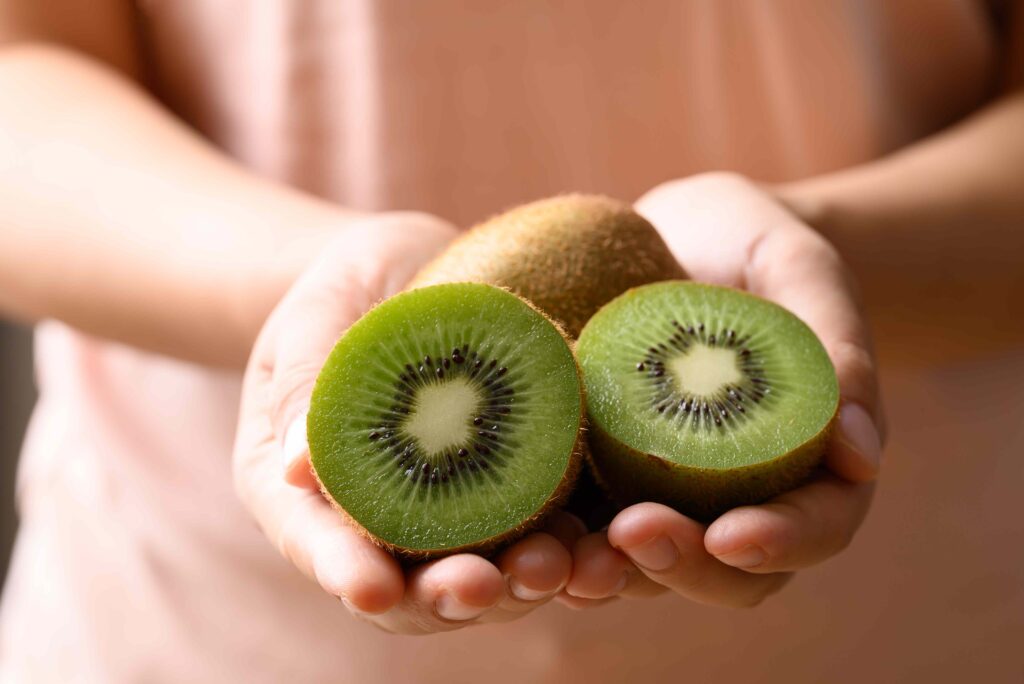Kiwis have gained attention for their digestive benefits, including keeping your bowel movements regular. Eating kiwi with the skin can boost its fiber content by up to 50%. The skin also contains nutrients that support heart health, like potassium and magnesium.
Kiwis with the skin on have many health benefits, including being nutrient-dense and boosting the immune system. They may also help with certain nutrient deficiencies and maintain balanced cholesterol and blood pressure levels.
Antioxidant-Rich
Kiwis are a rich source of antioxidants, a substance that protects cells from damage. These antioxidants include vitamin C and vitamin E, found in the skin. Eating kiwis with the skin on will raise your intake of these immune-boosting nutrients.
May Help with Iron Absorption
Vitamin C helps your body absorb iron, particularly non-heme iron, a type of iron found in plants. Eating kiwi with the skin, along with iron-rich plant foods, may be particularly beneficial for people prone to iron-deficiency anemia. Iron deficiency anemia is when your body doesn’t have enough iron to produce hemoglobin, a protein that carries oxygen to your blood.
In a study involving people with low iron levels, consuming two kiwifruits alongside an iron-fortified breakfast cereal daily for 16 weeks significantly improved iron levels. By the end of the trial, iron levels were within the normal range.
May Benefit Blood Pressure
Kiwis contain potassium in both the fruit and the skin. Potassium is an essential mineral that helps maintain a healthy balance with sodium, another important nutrient the body needs. This balance is important for keeping blood pressure in check, since high sodium levels can raise your blood pressure. Magnesium, another mineral found in kiwi skin, helps relax blood vessels, tubes that carry blood throughout the body, and supports healthy blood flow.
Laxative Benefits and Colon Protection
The extra fiber in kiwi skin can support good digestion and healthier bowels. Research suggests that eating gold kiwis with the skin can increase fiber intake by 50%.
Eating kiwis, including the skin, has two laxative benefits. The first is that it supports smoother, more regular bowel movements. The second benefit happens when the fiber from the skin reaches your colon, which is then broken down by healthy gut bacteria. This makes substances called short-chain fatty acids (SCFAs), which help protect your colon and may lower your risk of colorectal cancer and related conditions.
Cholesterol Control and Immunity
Kiwi, which is naturally cholesterol-free, contains soluble fiber that helps maintain cholesterol levels and immunity. Soluble fiber, a type of fiber that dissolves in water, slows digestion and can help control cholesterol and blood sugar levels.
Soluble fiber also supports a healthier gut, which can strengthen the immune system and possibly help you recover faster when you’re sick.
While kiwi fruit boasts a bright, sweet-tart flavor, the skin may be more earthy or bitter.
If you opt for either a gold kiwi or a hardy kiwi (kiwiberry), a grape-sized variety, you can enjoy a more delicate and fuzz-free skin. Whereas commonly consumed kiwis have a fuzzy skin and coarser texture.
Eating a kiwi with its skin is generally safe. However, it may not be suitable for everyone. Some people should avoid consuming kiwi with the skin due to potential discomfort or health concerns, including:
- Sensitive mouth or acid sensitivity: Kiwi is highly acidic. This acidity can cause a tingling or burning sensation in the mouth or on the tongue, especially for those with sensitive oral (mouth) tissues, dry mouth, or conditions like gastroesophageal reflux disease (GERD) or laryngopharyngeal reflux (LPR), where acid reflux can reach the throat and mouth.
- Oral allergy syndrome (OAS): Kiwi contains proteins similar to certain pollen allergens, such as tree pollen. People with OAS may experience itching, tingling, or mild swelling in the mouth and throat after eating raw kiwi, particularly with the skin.
- Kidney stones: Kiwi skin contains calcium oxalate crystals, a type of salt that can irritate tissues in the mouth. Consuming foods high in oxalates may contribute to kidney stones, particularly for people prone to them.
- Latex allergy: Kiwi contains certain proteins similar to those found in latex. People with a latex allergy should avoid kiwi because these latex-like proteins can trigger mild to severe reactions, such as sneezing, itching, and difficulty breathing.
- Actinidin: This is a major allergen in kiwi fruit that may cause sensitivity in people without an allergy. Because actinidin is a substance that breaks down proteins, it may create a temporary, mild burning or tingling on the tongue or mouth.
Some recommendations for getting the best taste and experience of eating kiwi fruit with the skin:
- To ripen your kiwi, wrap the fruit in a paper bag and keep it at room temperature for two to three days. Avoid direct sunlight.
- Store ripe kiwis in your refrigerator at 32-35 degrees Fahrenheit.
- Keep your kiwis away from fruits like bananas, apples, and avocados, because the gases they make can cause your kiwis to overripen.
- Clean your kiwis with fresh, cool water. You can use a produce brush to remove any dirt or debris. Dry with a clean towel. If the skin is fuzzy, you can use the towel to rub off the fuzz. If any leftover fuzz makes eating it whole off-putting, consider turning it into a smoothie.
- For a less hairy experience, consider trying a gold kiwi or the hardy kiwi.
Kiwi is a heart-healthy fruit with digestive benefits. However, eating it with the skin can raise these effects. Kiwi skin is nutrient-dense and adds to the fruit’s fiber content.
Eating kiwi with its skin may further boost digestion and regularity, and potentially improve your iron levels when consumed daily with other iron-rich foods.


